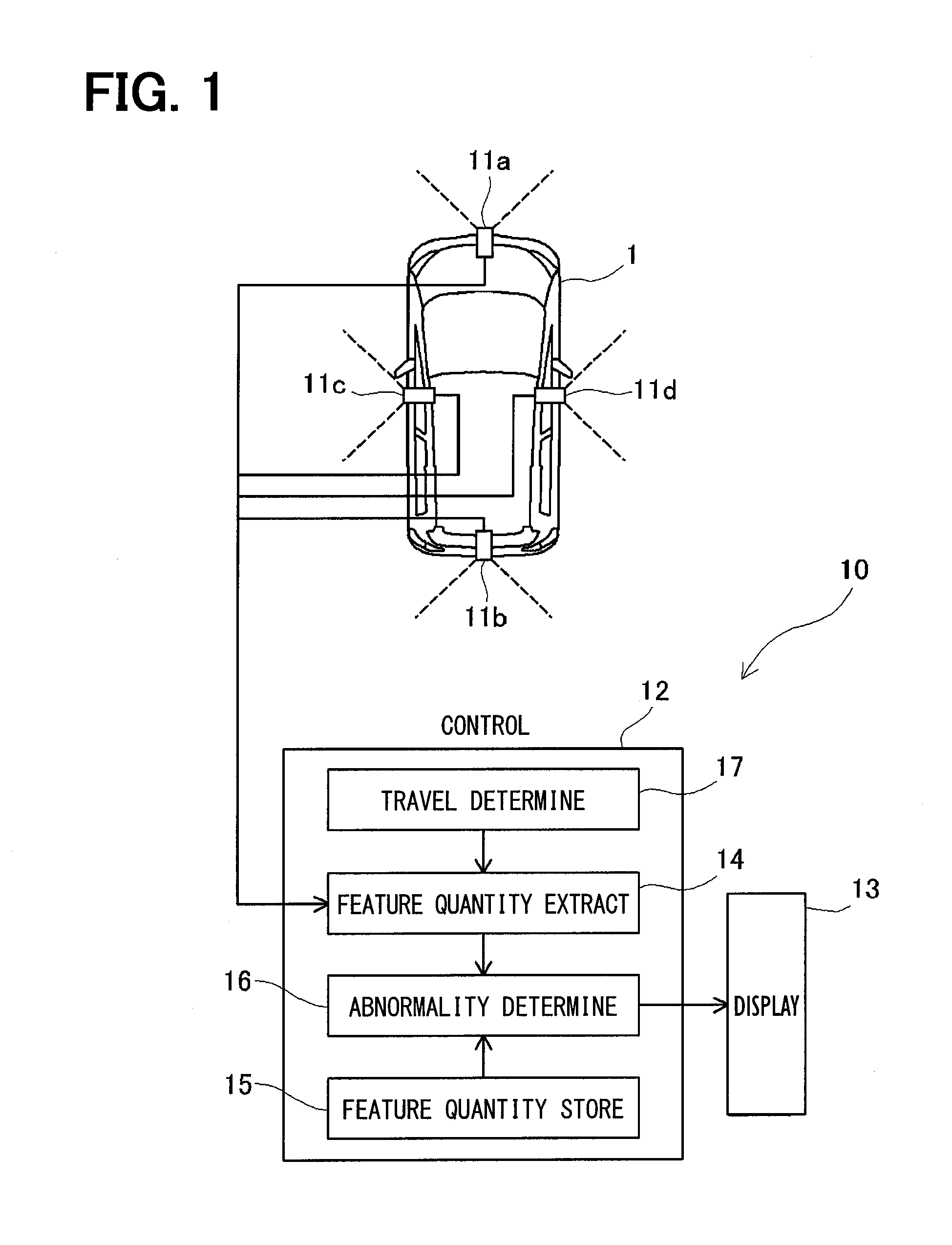Image analysis apparatus and image analysis method
an image analysis and image technology, applied in the field of image analysis apparatus and image analysis method, can solve the problems that the on-vehicle camera may change without the driver's knowledge, and achieve the effect of high accuracy
- Summary
- Abstract
- Description
- Claims
- Application Information
AI Technical Summary
Benefits of technology
Problems solved by technology
Method used
Image
Examples
first embodiment
A. Apparatus Configuration
[0025]FIG. 1 illustrates a configuration of the image analysis apparatus 10 disposed in a vehicle 1 (referred to also as a host vehicle). The image analysis apparatus 10 according to a first embodiment analyzes images captured by on-vehicle cameras 11a-11d (front camera 11a, rear camera 11b, left camera 11c, and right camera 11d), which are mounted on the front, rear, left, and right of the vehicle 1, determines whether the on-vehicle cameras 11a-11d are mounted in respective abnormal positions, and notifies the results of determination. Although details are not given here, the on-vehicle cameras 11a-11d monitor the area around the vehicle 1, and a system separate from the image analysis apparatus 10 detects lane positions, obstacles, and pedestrians based on images captured by the on-vehicle cameras 11a-11d. Therefore, the on-vehicle cameras 11a-11d are mounted in predetermined positions of the vehicle 1 and at predetermined angles (the purpose of adjustin...
first modification
C-1. First Modification
[0052]The first embodiment calculates the brightness value of each pixel in the entire region of the front camera image (S204 of FIG. 3) and compares the “currently captured front camera image” against the “previously captured front camera image” on an individual pixel basis (S206). Meanwhile, a first modification calculates the brightness value of a pixel in a region (particular region) where the brightness value is likely to change when the front camera 11a is mounted in a normal position, and then compares the “currently captured front camera image” against the “previously captured front camera image”. That is, the first modification does not perform a process of calculating the brightness value or a process of comparing the “currently captured front camera image” against the “previously captured front camera image” on a region that is unlikely to change even when the front camera 11a is mounted in a normal position.
[0053]A hatched portion in FIG. 8A repres...
second modification
C-2. Second Modification
[0056]The first embodiment compares the actual feature quantity (the amount of change in the brightness value of the currently captured front camera image and the amount of change in the brightness value of the front camera image during the monitoring period) against the ideal feature quantity (threshold ratio α, threshold count β, first predetermined amount, and second predetermined amount), which is obtained when the front camera 11a is mounted normally, on the assumption that the ideal feature quantity remains unchanged irrespective of the speed of the vehicle 1. Meanwhile, a second modification determines the ideal feature quantity based on the speed of the vehicle 1 and compares the ideal feature quantity against the actual feature quantity.
[0057]As the conditions around the vehicle 1 greatly vary with an increase in the speed of the vehicle 1 no matter whether the mounting position of the front camera 11a remains unchanged, the amount of change in the b...
PUM
 Login to View More
Login to View More Abstract
Description
Claims
Application Information
 Login to View More
Login to View More - R&D
- Intellectual Property
- Life Sciences
- Materials
- Tech Scout
- Unparalleled Data Quality
- Higher Quality Content
- 60% Fewer Hallucinations
Browse by: Latest US Patents, China's latest patents, Technical Efficacy Thesaurus, Application Domain, Technology Topic, Popular Technical Reports.
© 2025 PatSnap. All rights reserved.Legal|Privacy policy|Modern Slavery Act Transparency Statement|Sitemap|About US| Contact US: help@patsnap.com



